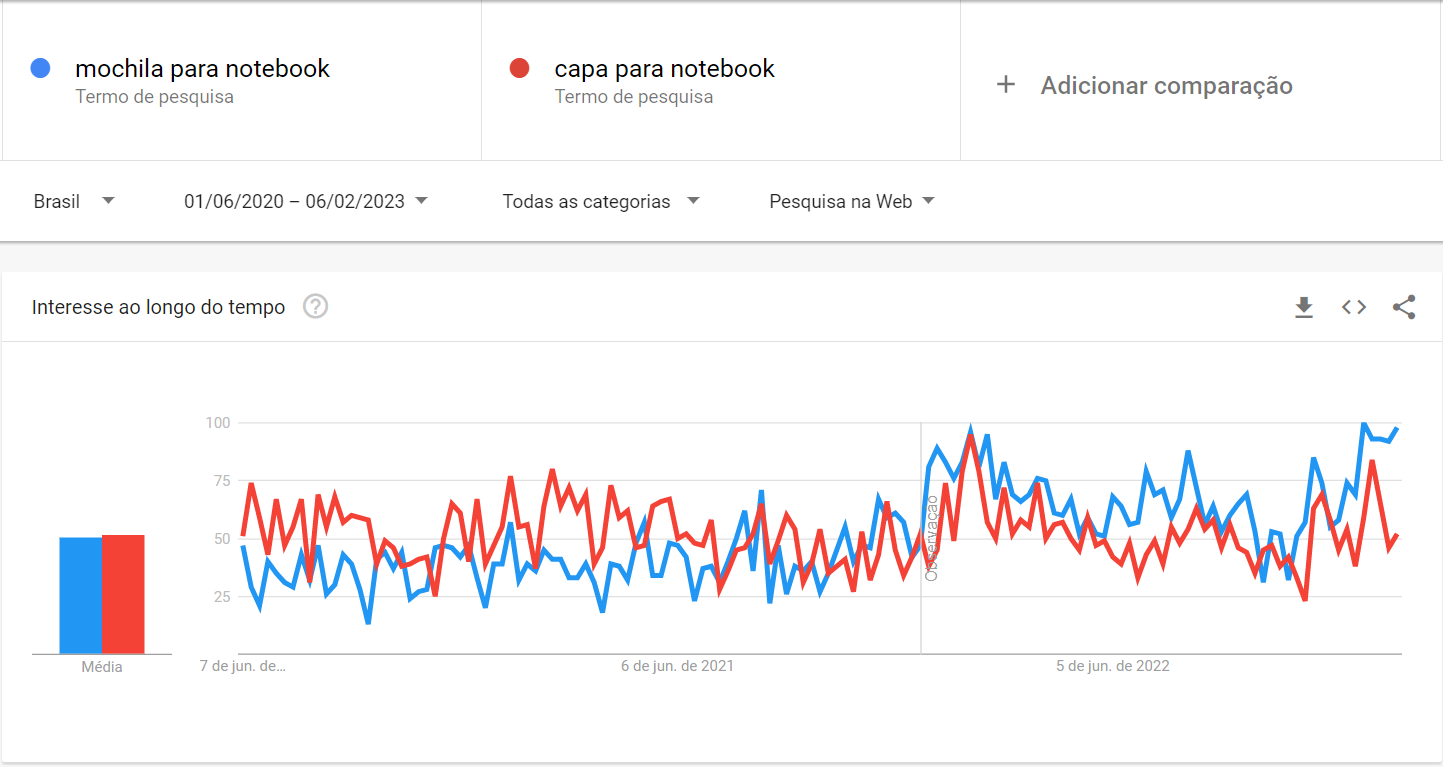
Would they buy my product? Is there a demand for my service? Will my business grow? These and many other questions permeate the daily lives of entrepreneurs and marketing professionals.
And for good reason: they basically determine whether a business should exist or not! That's where Google Trends, a powerful marketing tool, comes in. It will help you do market research to predict demands and trends in your segment.
See what you'll find in this article:
- What is Google Trends?
- How does Google Trends work?
- Where does Google Trends data come from?
- Why Use Google Trends?
- How to Use Google Trends in Your Marketing Strategy
What is Google Trends?
Google Trends is a tool created in 2006 that allows you to follow the evolution of searches for a given search term on Google over a selected period of time.
The tool also allows you to make comparisons between different terms and even estimate the seasonality or progress of a subject over a period of time.
The time interval can be customized by hours, days or years. From 2004 to the present day. In addition, other filters are applicable to the search, such as the country where the searches were made, the category in which it is found and the type of search.
Some examples of categories available in the tool are Arts, Cars, Science, Sports, Finance, Games, Health, Travel, etc. You'll notice that Google Trends offers several filter options.
- Location;
- Period;
- Categories;
- Type of search (images, website, YouTube, etc.).
How does Google Trends work?
By typing in a search term and selecting the filters, you can generate a graph with the searches on the vertical axis and the time period on the horizontal axis.
To give you a fun example, check out the searches for Game of Thrones in recent years in Brazil:

It's easy to conclude that these higher figures are equivalent to the period during which the seasons are aired on television.
The graph generated is presented as an index from 0 to 100, which represents the percentage of peak searches. This means that within the selected range, the peak of searches for the word will be 100, and all other values will be relative to it.
The downside is that it doesn't give us the exact number of searches for a given word in absolute terms. However, it is possible to study their evolution over time.
Analyzing a Google Trends graph is nothing less than analyzing the desires and habits of Internet users over the years.
Along with the graph, you may have noticed that there are three buttons in the top right-hand corner. These are used to download the data in CSV, to embed the HTML of the graph in any web page and to share the graph on social networks.
The results do not take into account special characters and searches carried out by a few people or by the same person over a short period of time.
Another interesting point is that Google Trends allows you to compare different types of words. For example, see the comparison between Game of Thrones and the Avengers in Brazil:
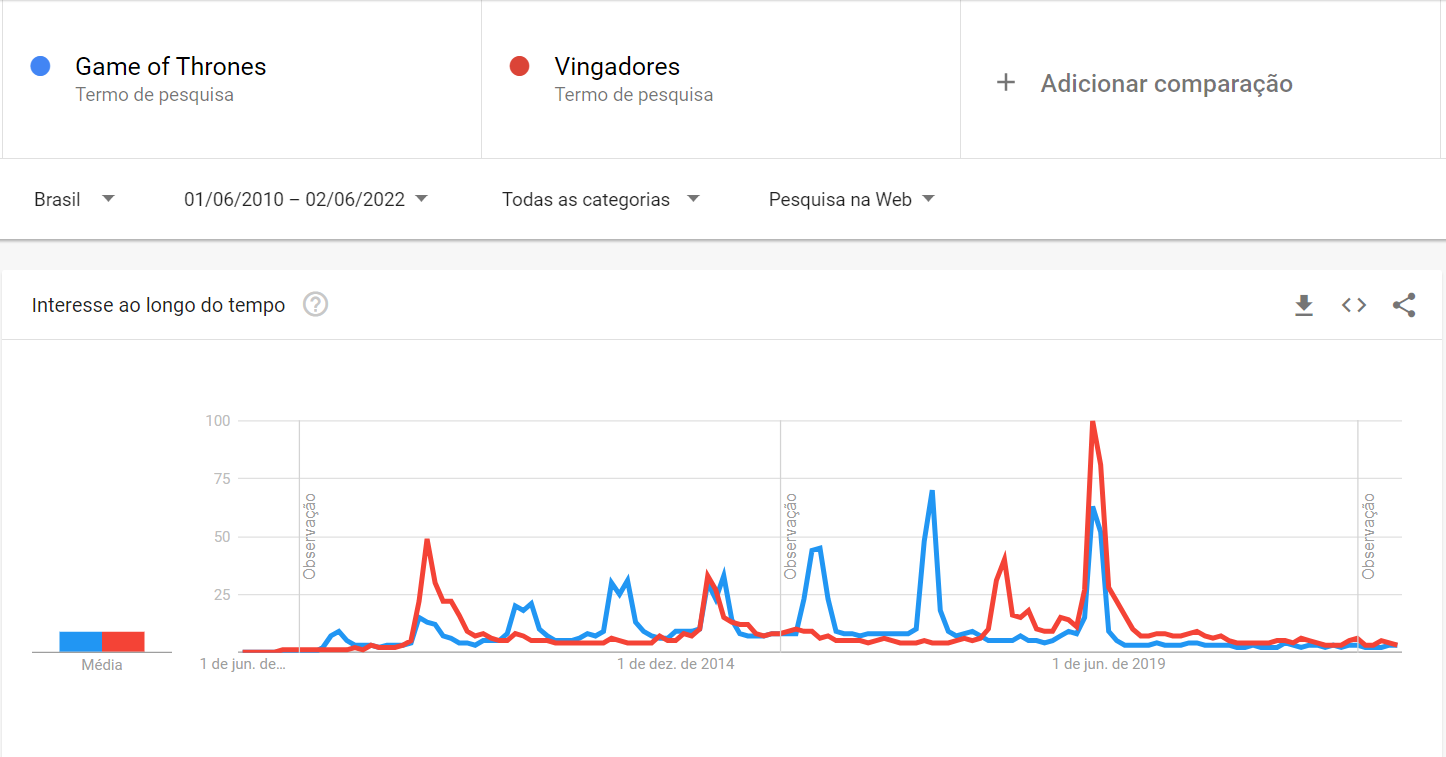
The graph for each word appears in a different color and on the left you can see the average number of searches in the range. The index 100 is now the peak of the most searched word, which in this case is "Avengers".
Where does Google Trends data come from?
Google Trends data comes from five different Google sources:
- Internet research;
- Image search;
- News search;
- Google Shopping;
- YouTube search.
Why Use Google Trends?
Google Trends is an essential tool for planning any online marketing and promotion strategy. Read on and see why you should use Trends to make your actions successful.
Producing Relevant Content
If you want to implement Inbound Marketing strategies to attract, convert and engage leads and turn them into customers, you need to develop content that is relevant to them.
So, a practical way of finding out whether a particular subject is hot or not is to use Google Trends! There's no point in putting together an excellent SEO strategy or creating incredible articles and blogs if you're talking about fax machines, which today hardly exist anymore.
Understand the evolution of searches for certain subjects or content, which is very important for blogs, SEO and Inbound Marketing.
Comparing similar terms
The first point we'd like to make here is the possibility of comparing terms based on Google Trends data. The idea here is to compare similar searches or similar products to find out which has the highest volume.
Another pertinent conclusion is to see if there is any geographical difference between the searches. Assuming that your e-commerce has coats and jackets as its main products, note what the results would look like in the example below:
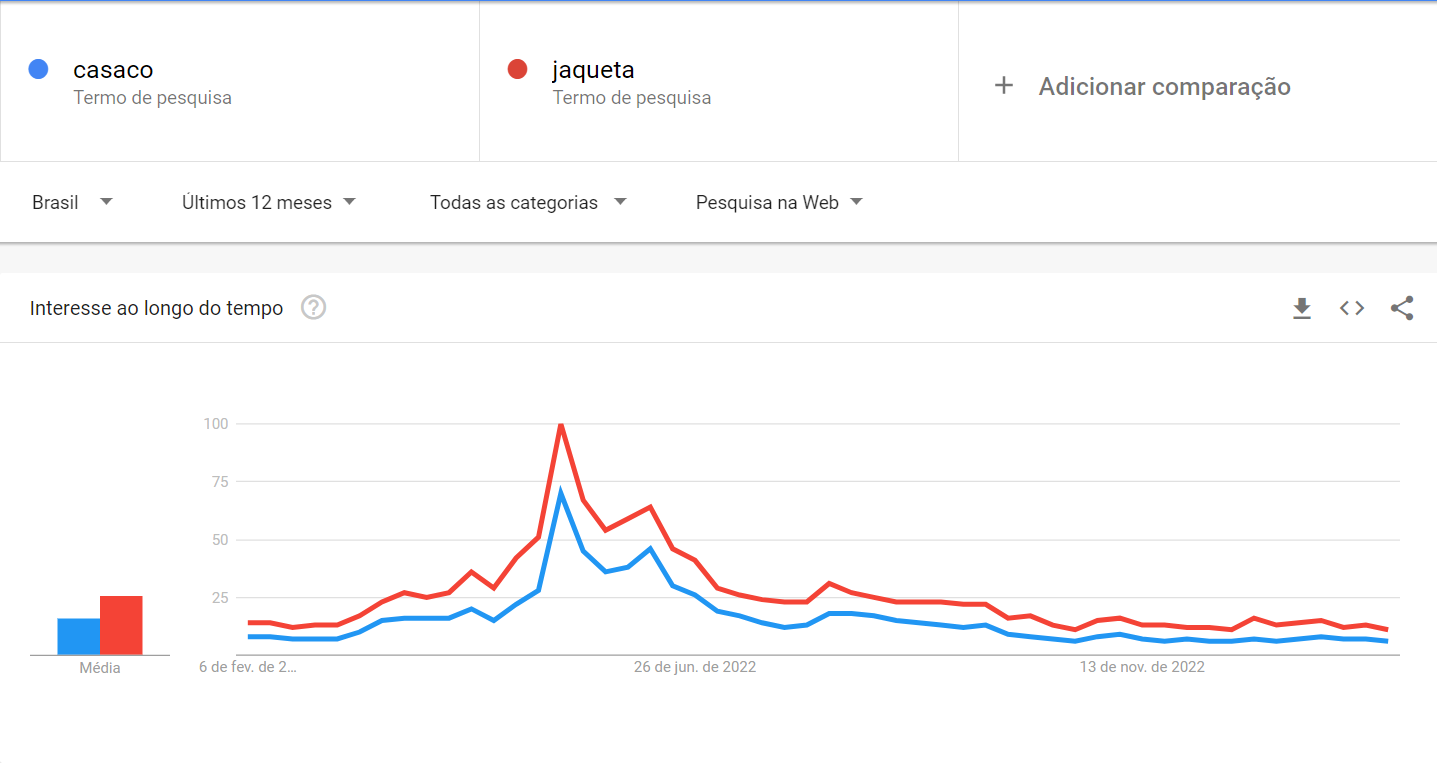

In general, jackets are more popular than coats online. This is a good direction to take when advertising online in Brazil.
On the other hand, if you only sell in Rio de Janeiro, this word might not be the best alternative. This is because there is a greater demand for the term "jackets" in this state.
Market Research
To do market research on Google Trends, the first step is to understand what you want to know. So, to start your market research, have a specific question in mind.
For example: "Do people like artisan burgers?".
There are only two answers to the above question - yes or no. This makes it easier to understand people's search intentions. Now, the second step is to think about which audience you want to understand. Are your customers from a certain region?
Okay, now that you have the two relevant questions for your market research, you can start your analysis to see if there is a tendency for people to like artisan burgers.
In this case, do a less geographically segmented search, see graphically the search trend for certain terms over time to understand whether the search for artisan burgers is growing or falling.
In the image below, for example, you can see the search trend for the term "artisan burger" in Brazil over the last few years. You can see that searches peaked in May 2020 and have been falling ever since.

Google Trends is suitable for more macro market research, with little local segmentation. But if you're interested in a single city or neighborhood, we can no longer use this tool.
In these cases, it is advisable to carry out a survey(online or offline), an interview or even active observation. The latter consists of going to an establishment that has the product in question and observing people's behavior.
Search for Trends
By analyzing research trends, you can identify new markets, market niches and business opportunities.
The trend represents the pattern of growth or decline of a variable over time. It is usually represented by the line that best describes the graph and, in some cases, can be intuitive just by looking at it.
A very simple way to find the Trend of a time series is through Google Sheets. By downloading the data from Google Trends in csv format and pasting it into Sheets, you can generate a graph and find the trend at the touch of a button.
Campaign Planning
By understanding search trends, you can plan your marketing strategies more effectively by investing in popular and relevant search terms. Again, you can play around with the filters for different regions, platforms and timeframes to check for variations.
For example, you may discover that trends in São Paulo are different from those in Rio de Janeiro or that there are differences in search behavior (desktop and mobile). You can apply this data to your strategies to maximize the effectiveness of your campaigns.
By creating trending content, you can reach people who may be interested in your products or services. Thus attracting them to your site, which helps increase the effectiveness of your remarketing ads.
Seasonality Analysis
Seasonality is characterized by fluctuations in cyclical behaviour over a shorter period. Like a week, a month, a season or even a year. We usually carry out this analysis on a month-by-month basis, indicating the months with the most and least research.
Unlike a trend, seasonality is harder to spot just by looking at a graph, but it is something that can happen.
A clear example is coats and jackets. If we extend the time period, we'll notice search peaks in May and June, the coldest months in Brazil.
Monitoring Competitors
The tool can also help you visualize the trends of your products and services in comparison with your competitors. In some cases the results can be really surprising, which is why doing competitive research with Google Trends can be useful for marketing purposes.
Google Trends shows where there are gaps and even challenges assumptions. Marketing teams can use this data as a springboard for improvement, either by analyzing competitors' marketing channels to see how to improve or by reallocating marketing spending to other areas.
How to Use Google Trends in Your Marketing Strategy
If you work in online sales or anything that deals with selling products, you can use Google Trends to expand into a different market or discover new markets for a new demand for your products. Here's how;
1. explore potential markets
Not only can you filter trending products based on location, but you can also explore the performance of a particular product in that region.
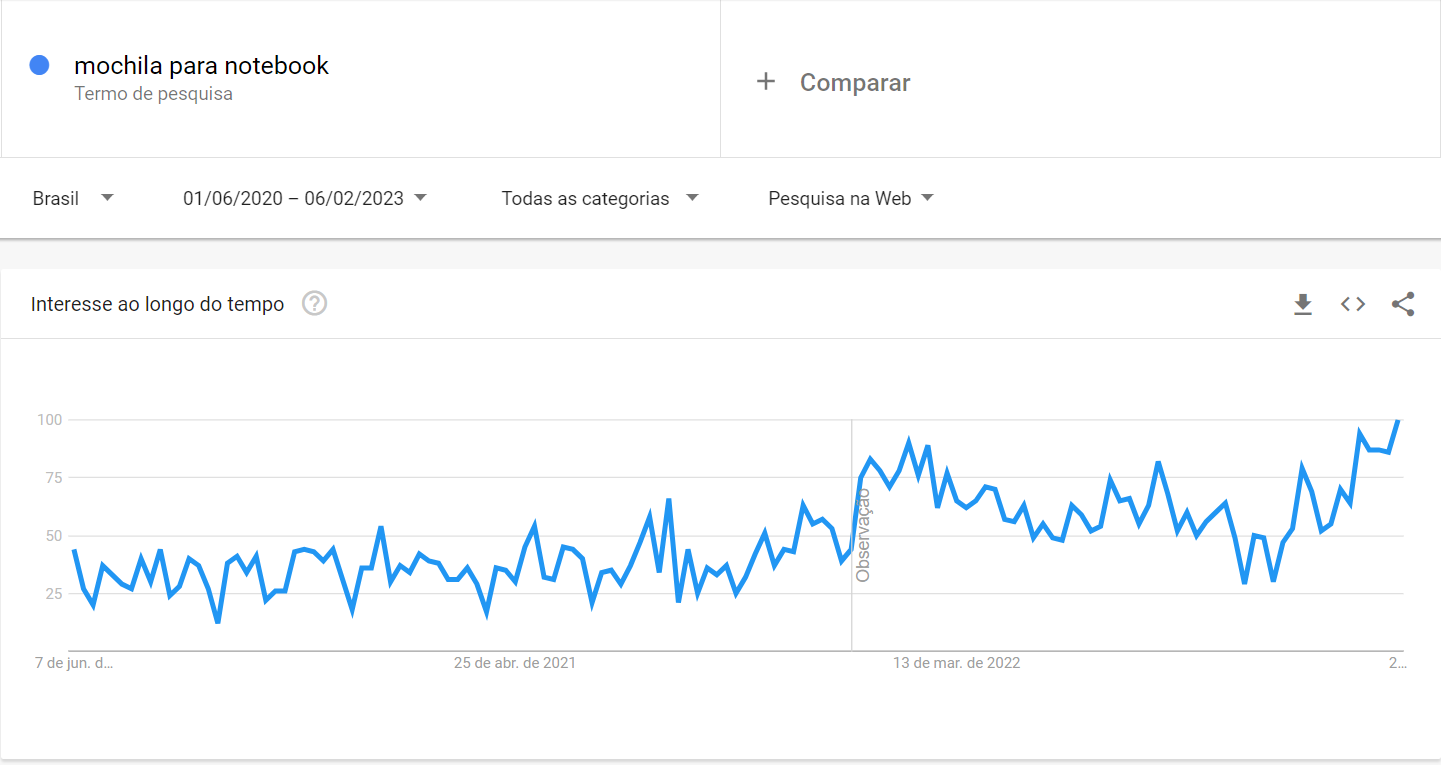
See the example of 'Notebook Backpack'. You can adjust the period for as long as it can be displayed. After all, we want a stable market, not seasonal peaks in demand.
Exploring it in this way helps to clarify whether demand is declining or on an upward trend. The graph above indicates that demand for notebook backpacks is growing in Brazil.
2. Discover Related Products
Google trends also display relevant and related terms. You can therefore use this function to discover product ideas that can support you in your current business.
Following the example above, suppose you have built an online business selling laptop backpacks to customers in Brazil.
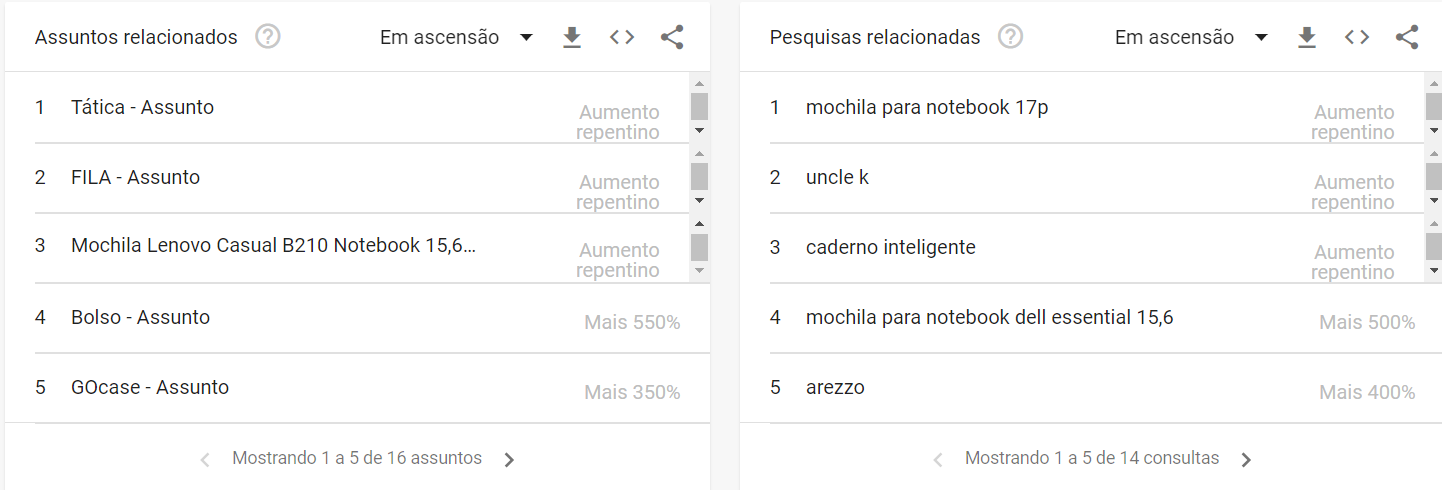
Now you can use Google Trends to find popular and profitable related products. Just type in the term 'Notebook Backpack', go to the related topics section and be surprised by the many product ideas.
3. Compare Most Popular Products
I've already said that Google Trends' comparison functionality is incredible. You can use it to identify a more popular product to adjust your business strategy.
Let's compare the terms 'Notebook Backpack' and 'Notebook Sleeve'. The research reveals that both terms fluctuate in people's purchasing intentions - an invaluable insight to help with your business decisions.
4. Combine Trend with Seasonality
By combining macro trend analysis with micro seasonality analysis, you'll have powerful information for planning a marketing campaign budget.
With these two pieces of information you can understand how a particular product or brand performs over time. Some may even venture to make projections for future months. It's a difficult task, but one that becomes more tangible with access to this information.
Details and Other Features of Google Trends
Now that you know the main functions of Google Trends and how to use it in your marketing strategy. Check out other features of the tool and options that go beyond the search field.
Home page
The Google Trends homepage provides an overview of real-time search trends. When you access the home page, you'll see different sections and resources offering information on the most popular topics and searches of the moment.
Explore
In this section, you will find stories and analysis related to current research trends. These articles provide a more detailed look at popular topics, including insights into what drives public interest, recent related events and other relevant information.
On the rise
The main searches carried out on Google are displayed here. This section offers insights into what people are looking for at the moment, covering a variety of categories such as news, entertainment, sports, health, technology and much more.
In addition to these main features, the Google Trends homepage can also include other sections or temporary features, depending on current events and emerging trends.
Conclusion
In this article, we'll show you some ways of using Google Trends to boost your Digital Marketing strategies. All the suggestions presented are simple and easy, but can have a huge impact on your campaigns.
How about running these analyses for the important keywords in your business? Start with your brand name and then your main products. Over time, you'll have powerful insights in your hands!
Remember that Google Trends is just a tool to help you understand market and target audience trends. It is important to carry out a more in-depth analysis and combine the information obtained with other sources before making business decisions.



